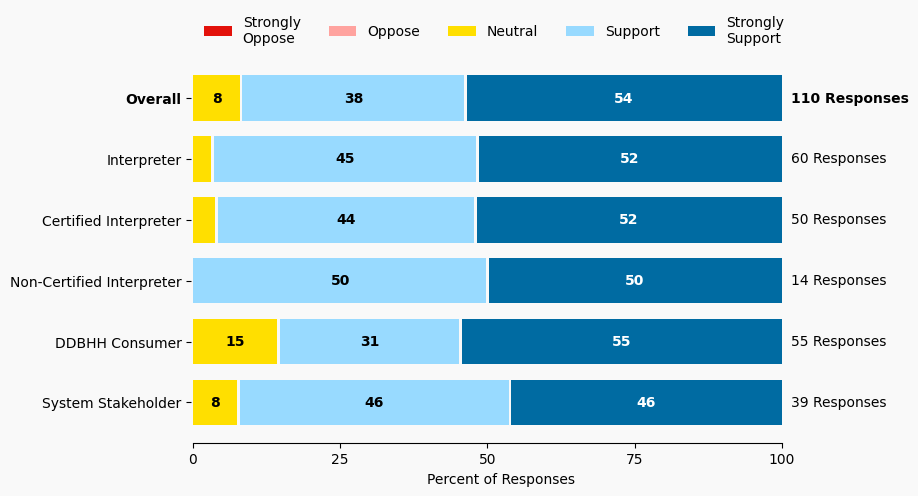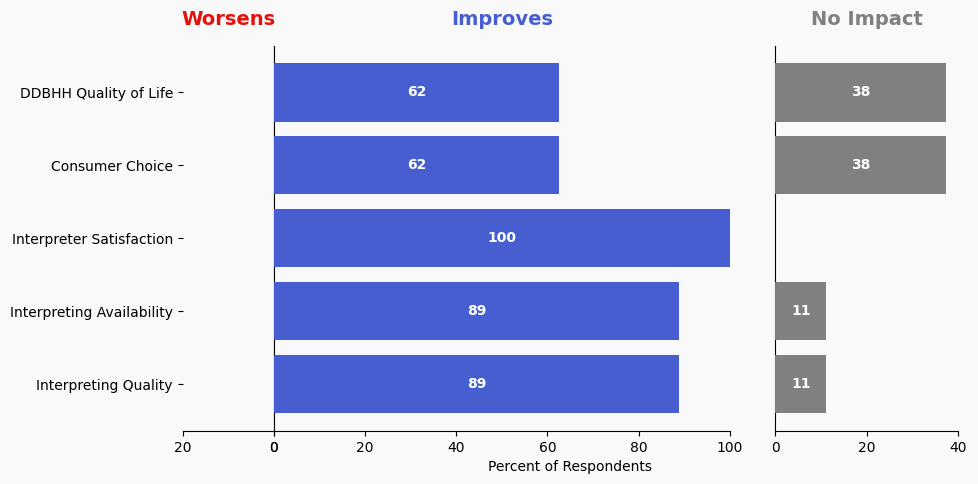111 Expand Communities of Practice to Focus on Retention of Emerging Interpreters
Issue: Some emerging interpreters feel a lack of connectedness to the interpreting community. New interpreters do not always have opportunities to develop relationships with interpreters at all stages in their career. If interpreters have stronger relationships within the interpreting community, they have more sense of belonging and a network to support them. With a support network, new interpreters are better prepared to work together in different settings.
Proposed Solution: Interpreter referral companies pay into a fund to support a new Community of Practice developed by the Whole Interpreter Enterprises (Arlyn Anderson) focused on retention of emerging interpreters.
Expected outcome: Increased retention of interpreters
Who is impacted: Interpreters
Timeline: 6 months

Summary of Support Image Description
The stacked bar charts show how respondents rated their level of support and the total number of responses. The percentage for the five support levels is shown from left to right: Strongly Oppose (Dark Red), Oppose (Light Red), Neutral (Yellow), Support (Light Blue), and Strongly Support (Dark Blue).
Respondents may identify with multiple subgroups. The overall level of support is:
Overall
Strongly Oppose: 0%
Oppose: 0%
Neutral: 8%
Support: 38%
Strongly Support: 54%
Click to see the detailed image description for each subgroup.
Interpreter
Strongly Oppose: 0%
Oppose: 0%
Neutral: 3%
Support: 45%
Strongly Support: 52%
Certified Interpreter
Strongly Oppose: 0%
Oppose: 0%
Neutral: 4%
Support: 44%
Strongly Support: 52%
DDBHH Consumer
Strongly Oppose: 0%
Oppose: 0%
Neutral: 15%
Support: 31%
Strongly Support: 55%
Non-Certified Interpreter
Strongly Oppose: 0%
Oppose: 0%
Neutral: 0%
Support: 50%
Strongly Support: 50%
System Stakeholder
Strongly Oppose: 0%
Oppose: 0%
Neutral: 8%
Support: 46%
Strongly Support: 46%
Overview of Respondents Opting for In-Depth Solution Analysis
After indicating their support level, 7% of the 110 respondents opted in to further assess whether the solution would worsen or improve on five metrics. Of the opt-in reviewers (8 respondents), 100% supported the solution, 0% were neutral on the solution, and 0% opposed the solution.
The remaining 102 respondents did not opt in to further assess the solution. Of these people, 91% support the solution, 8% were neutral on the solution, and 0% opposed the solution.
Reviewer Evaluation of Solution Effectiveness

Solution Effectiveness Image Description
The stacked bar charts show how respondents assessed the effectiveness of this solution based on five metrics. For each metric, the percentage of respondents is shown from left to right: Worsens (Red), Improves (Blue), No Impact (Gray).
DDBHH Quality of Life
Makes It Worse 0%
Makes It Better 62%
No Impact 37%
Interpreter Satisfaction
Makes It Worse 0%
Makes It Better 100%
No Impact 0%
Consumer Choice
Makes It Worse 0%
Makes It Better 62%
No Impact 37%
Interpreting Availability
Makes It Worse 0%
Makes It Better 88%
No Impact 11%
Interpreting Quality
Makes It Worse 0%
Makes It Better 88%
No Impact 11%
Reviewer Feedback and Insights
Interpreter
Comments from Interpreters emphasize the need for more connection and support in ethical practices and for specialty groups like DI/HI teams, K-12, medical, and legal interpreters. One comment expresses enthusiasm for starting up Communities of Practice quickly to foster connections, especially with interpreters at different career stages, and to prevent burnout and compassion fatigue. Another comment suggests having an interpreting specialist under state partnership to ensure diverse and consistent services.
Deaf, DeafBlind, Hard of Hearing
No comments were submitted.
System Stakeholder
Comments from System stakeholders raise concerns about funding through agencies and centralizing funding through a private company, suggesting that a state partnership with community organizations may offer more sustainable support.
PREVIOUS SOLUTION
110 Increase and Enhance Paid Internships with Active Mentoring
Issue: Interpreters need more opportunities for internships and/or mentoring in their field.
NEXT SOLUTION
112 Centralize Information about Communities of Practice on a Website
Issue: Interpreters often experience vicarious trauma, compassion fatigue and related issues due to working in stressful settings. Interpreters need mental health supports in place
Leave a Reply